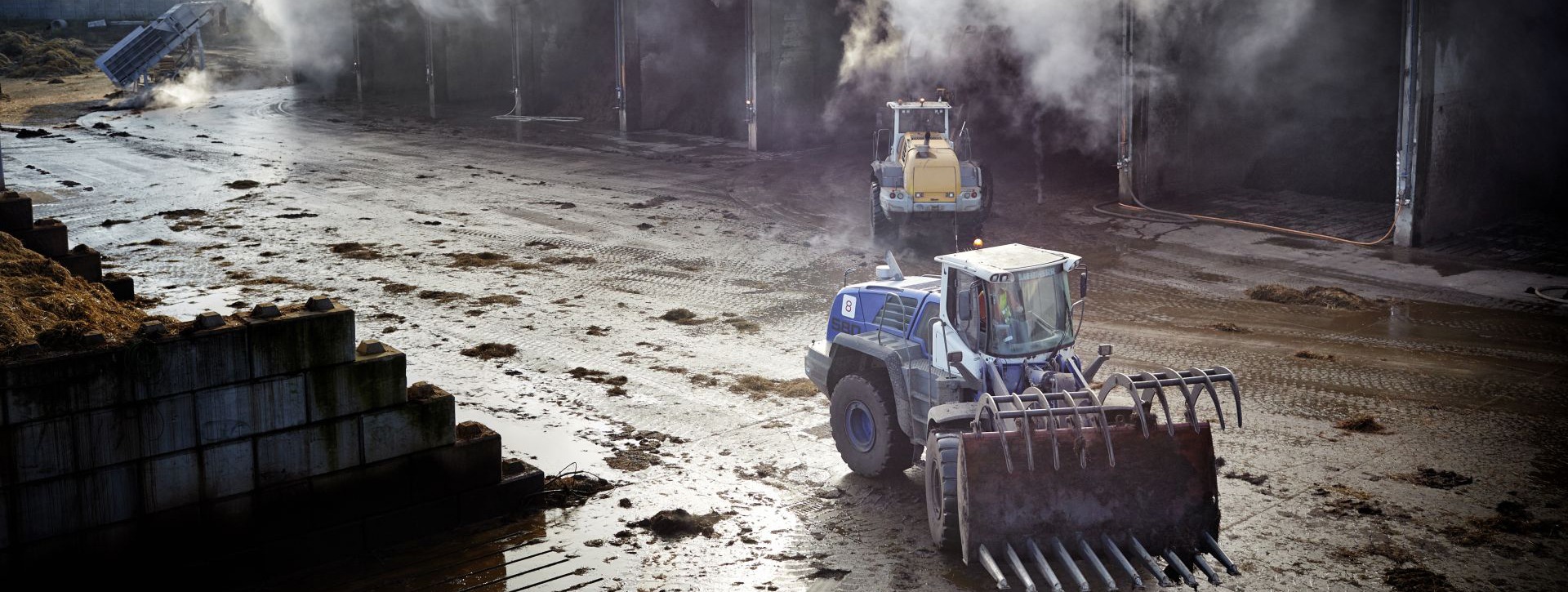The moment when a champignon is available to the consumer on the shop shelf is preceded by many complex processes.
Our company integrates activities from the production of substrate on which champignons are cultivated, their cultivation and delivery of properly packaged mushrooms to the customer. Substrate production is a complex process which has no fixed recipe. The substrate for champignon cultivation is a unique living organism with variable properties. Our substrate production facility is managed by an experienced team that oversees the quality of the entire production process. The substrate that we produce goes not only to our own mushroom farms, but also to external Customers.
PHASE I – FERMENTATION
The main raw material for the substrate is straw. As the main raw material which highly influences the quality of the produced substrate, we pay a lot of attention to it. We motivate our suppliers to adhere to good practices and quality standards in the growing and harvesting process. We store our straw in roofed halls which protect it from adverse weather conditions, thus preserving its freshness and high quality for longer. In addition to straw, chicken manure and gypsum are used to produce the substrate. All raw materials are subject to detailed quality control, using the organoleptic and laboratory method in our professional laboratory. The product formed after the combination of raw materials is stored on aerated floors and then transported to bunkers for controlled fermentation. In this phase the substrate reaches a temperature of about 800C . The process of Phase I takes about 2 – 3 weeks, depending on the season. After this period, the substrate is subjected to Phase II processes, i.e. pasteurisation.

THE QUALITY OF THE SUBSTRATE OF PHASE I
IS THE KEY TO FURTHER SUCCESS
PHASE II – PASTEURISATION
After the fermentation is completed, the pasteurisation phase follows. The pasteurisation process is fully controlled and takes place in specially designed closed tunnels, equipped with a modern climate control system. The purpose of substrate pasteurisation is to get rid of undesirable organisms. This process takes place as part of a special hygiene programme which ensures that the selected substrate for mushroom cultivation is obtained. Pasteurisation ensures that the substrate that goes into the cultivation hall is clean, free of diseases and other forms of fungus. The pasteurisation process takes about 6 days. After the pasteurisation phase, the substrate is cooled and planted with mycelium. Planting takes place in a closed hall, which meets the appropriate hygienic conditions. After the mycelium has been planted, the substrate is transported to Phase III tunnels.
PHASE III – INCUBATION
Phase III is also called the incubation phase and lasts about 16 – 19 days. During this time mycelium grows in the mass of the substrate. The incubation process takes place in the same type of tunnels as Phase II. They are also specially designed and equipped with a computerised climate control system. After a period of 16 – 19 days, the substrate is unloaded from the incubation tunnels onto special truck trailers and then transported to the cultivation halls. It is possible to add a supplement to the substrate of Phase III enriching it with an additional portion of minerals and vitamins necessary for champignon formation and growth. The substrate produced in our production plant goes both to our champignon farms and to external customers. The whole process of producing the Phase III substrate therefore takes about 6 weeks, i.e. from the initial mixing of the raw materials in Phase I to reaching the finished Phase III substrate.
PHASE IV – MYCELIUM GROWTH
The overgrown Phase III substrate is transported to the production plant for Phase IV substrates, where it is placed in metal trays using a special loading line and covered with approximately 5 cm of peat cover. The individually designed line allows two cars to be unloaded at the same time, so that the substrate is even better mixed and the crop is more even. Trays filled with the Phase III substrate with a layer of peat cover by means of a special conveyor system are directly transported to the overgrowth halls where the mycelium growth process begins. Our cultivation halls are specially designed for Phase IV soil cultivation and the production process is highly automated. The halls are equipped with a modern climate management system which creates a suitable environment for the natural growth of mycelium and mushroom formation. As a result of the production process, which lasts about 14 days, mycelia overgrow from the substrate through a layer of moist peat cover. Consequently, small mushroom heads (so-called pins) start to appear which, under the influence of appropriate humidity, temperature, carbon dioxide and proper air movement, grow up and transform into champignons. This is the moment when the mobile trays can be transported to independent halls where champignon harvest begins. Our champignon farms are fully working in the Phase IV substrate system. Some of the trays with the Phase IV substrate go to the champignon farms of our customers who continue to cultivate and harvest the mushrooms.

OUR MODERN LABORATORY ENSURES THE HIGHEST STANDARDS OF TEST RESULTS
WE TAKE CARE OF EVERY DETAIL!
With our own laboratory, we can guarantee that substrate tests are carried out reliably and at the highest level. The quality control of our substrate is carried out using organoleptic and laboratory methods and the whole production process is monitored by means of an integrated computer system. Our modern laboratory ensures the highest standards of test results. Substrate samples taken during the production process are sent to the laboratory to determine their parameters. The quality control of the substrate is carried out using both organoleptic and laboratory methods, and the entire production process is monitored using an integrated computer system.











































